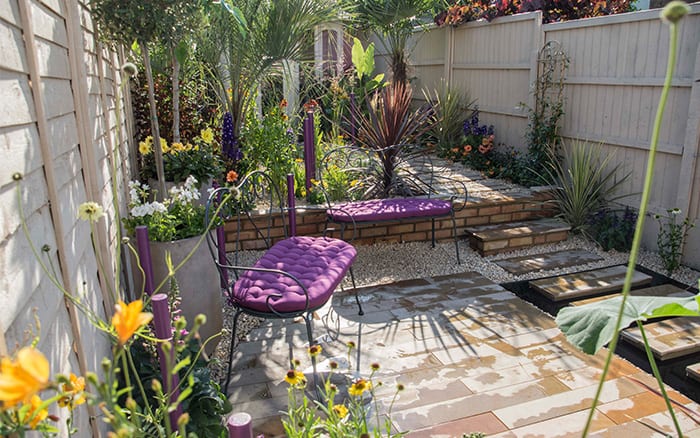It was another great episode for series 4 – here’s what we learned from the show this week. Plus find out how to use plants to get the coastal look in your own garden!
1 Colour schemes unite the garden
If you have a favourite colour, don’t be afraid to use it in the garden design! Having a colour ‘theme’ allows you to create different areas, as the colour unifies the garden. Purple was Joan’s favourite, so we used it throughout the design.
You can create complementary colour schemes using similar colours, such as red and blue with purples, or create contrast like we did. Choose colours on the opposite side of the spectrum – a colour wheel is a great help.
Contrasts work best in groups of three, so we used yellow and green with our purple plants. The possibilities are endless!
We used great purple plants like the Salvia ‘Purple Rain’, Cordyline ‘Torbay Red’, Perovskia atriplicifolia and purple foxgloves.
2 You can widen a narrow garden
There are plenty of ways to make your narrow plot feel more spacious. Use diagonals, curves and circles in the design to break up the depth. Create a meandering path that moves up to the edges to add width.
Add strong focal points and use height to lift the eye up. Tall plants and trees, structural features and even hanging baskets all give the eye something to focus within the garden, rather than looking at the boundaries.
If you have decking, set the boards to run horizontally to create the illusion of extra width.
3 There’s a water feature for everybody
I know so many gardeners who say the water feature is their favourite part of the garden. But even simple ones can be really effective.
In the show I created some floating paving stones over a pond. To do this at home, build supports up the sides and lay a joist across the pond where the steps will be. Cover this with concrete, and lay the paving slab on top while it’s still wet. The slabs should sit just above the water level.
I also added black aquatic dye to the water – this makes the pond look deeper than it is, and inhibits algae. It’s harmless to wildlife. The same trick was used in the One Show garden at Hampton Court Palace Flower Show.
4Permanent planters are possible
Container gardens are known for their variation. But if, like Joan, you’re not a keen gardener, they can feel like a lot of hard work. Sometimes, you just want something permanent, low maintenance and high impact.
Plant up containers with big, bold plants that look good all year round. Try evergreens like conifers with ivy, or small trees like the Ginkgo biloba we used.
You can also have fruit trees like fig and olive, which look great underplanted with bright flowers.
Water the containers well and feed with a general fertiliser in spring and summer to keep plants healthy and happy.
5 Texture is not just about how it feels
When we talk about texture in the garden, many people think of tactile plants. But visual texture plays a huge role. It gives the garden mood and sensuality.
Fine textures are plants that have small, narrow leaves close together. Use them en masse and balance them with some coarse-textured plants. These are plants with large, widely spaced leaves. Limit their use if your garden is small, as they can make it feel cramped.
We used fine-textured Calamagrostis acutiflora with coarse-textured Cordyline ‘Torbay Dazzler’.



Leave A Comment